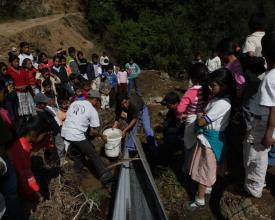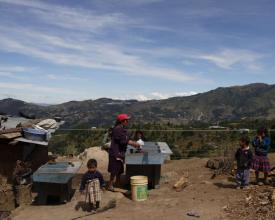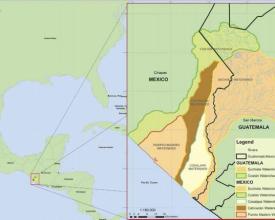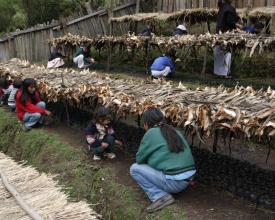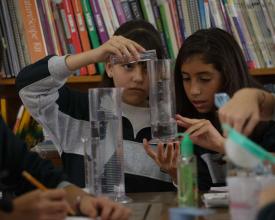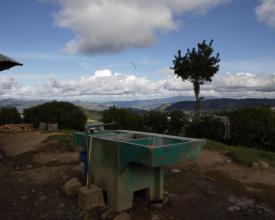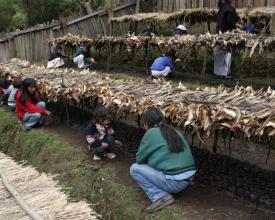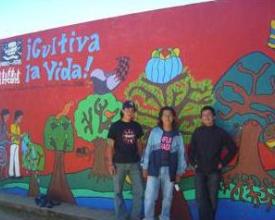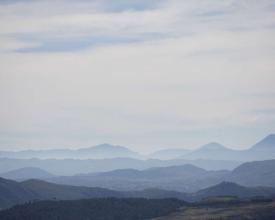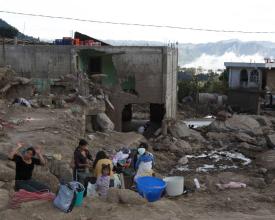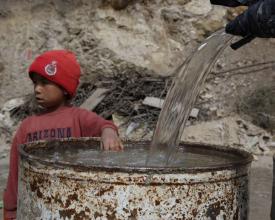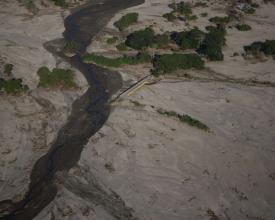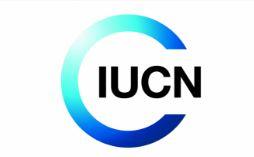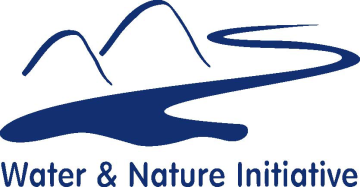
Les bassins versants de Tacaná : Mise en œuvre d'une gouvernance transfrontalière de l'eau par le biais d'une action communautaire locale fondée sur l'écosystème
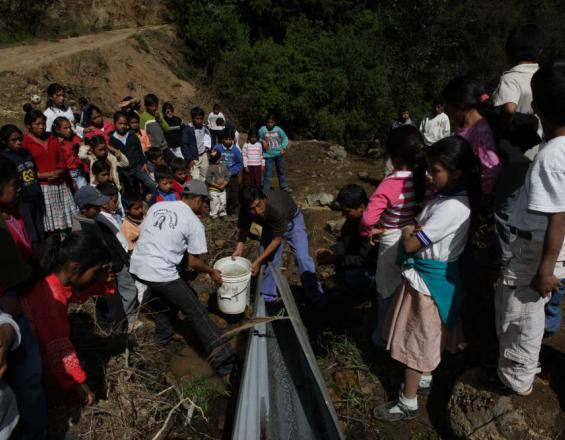
Malgré leur grand potentiel et leur importance stratégique, les bassins versants du volcan Tacaná sont vulnérables tant sur le plan écologique que politique. L'UICN (par l'intermédiaire de l'initiative Eau et Nature, WANI) et ses partenaires ont donc mis en place un projet de démonstration dans ces bassins versants, qui combine des projets pilotes de subsistance (conservation de l'eau, des sols et de l'environnement) et une gouvernance intégrée ascendante de la gestion des ressources en eau (gestion de l'écosystème d'eau douce).
Contexte
Défis à relever
Les bassins versants du volcan Tacaná sont d'une grande importance stratégique pour le Guatemala et le Mexique, car ils fournissent de l'eau aux villes situées en aval, de l'eau d'irrigation pour l'agriculture et, dans les parties basses, de l'eau pour la pêche. Malgré ce grand potentiel, la région est vulnérable tant sur le plan écologique que politique. Le climat est tropical humide et il y a une forte occurrence d'ouragans ainsi qu'une activité volcanique. La déforestation et la dégradation des bassins versants supérieurs et des berges des rivières ont entraîné l'érosion et des inondations et réduit la capacité des bassins versants à absorber l'eau. La région est également exposée à un certain nombre de problèmes sociopolitiques tels que le manque de soutien technique entre les institutions, la marginalisation des populations indigènes, les taux élevés d'analphabétisme et de mortalité, la très forte croissance démographique et la complexité des droits fonciers.
Emplacement
Traiter
Résumé du processus
Les éléments constitutifs travaillent ensemble pour atteindre l'objectif principal de l'initiative Eau et Nature (WANI), qui est d'"intégrer une approche écosystémique dans les politiques, la planification et la gestion des bassins versants". Les activités sont donc structurées autour des objectifs stratégiques de l'initiative, à savoir
- Démontrer la gestion des écosystèmes dans les bassins hydrographiques.
- Soutenir la gouvernance avisée des ressources en eau et des zones humides.
- Développer et appliquer des outils économiques et des mesures d'incitation .
- Donner à la population les moyens de participer à la gestion durable de l'eau.
- Améliorer les connaissances pour soutenir la prise de décision.
- Tirer des enseignements pour sensibiliser à l'utilisation rationnelle de l'eau.
Blocs de construction
Mobilisation des connaissances
La mobilisation s'est faite par l'évaluation économique des ressources en eau, la fourniture d'informations disponibles localement et le renforcement des capacités d'apprentissage et de direction.
- Le partenariat "Living Water" du projet a mis en place un système de paiement pour les services écosystémiques au Guatemala afin de protéger et de restaurer les ressources naturelles des bassins versants de Tacaná, en se concentrant principalement sur l'eau.
- Au Mexique, WANI a facilité la mobilisation de la base en créant des "bibliothèques virtuelles de ressources en eau" dans les mairies de cinq municipalités. Ces bibliothèques permettent d'accéder à des informations et à des connaissances actualisées sur les ressources en eau et l'environnement dans la région.
- Les enseignements tirés des projets pilotes de la WANI ont été intégrés dans les études universitaires de l'université de San Carlos par le biais de stages de dix mois. Ces programmes créent une masse critique de professionnels formés aux concepts, aux approches et aux pratiques de la WANI, qui occuperont par la suite des postes professionnels dans différentes institutions et organisations actives dans ce domaine, créant ainsi une boucle de rétroaction influente.
Facteurs favorables
- Confiance et bonnes relations avec les institutions locales.
- Informations disponibles localement.
Leçon apprise
-
La production de connaissances locales permet de mieux se préparer aux catastrophes et d'accroître l'ouverture politique sur l'eau au niveau des municipalités et de l'État.
-
La portée du projet aurait pu être plus large en termes de partenariats avec les parties prenantes. Le secteur privé a été inclus dans les programmes de paiement des services liés aux bassins versants dans la partie centrale du bassin versant, mais uniquement pour les petits exploitants. Dans la partie inférieure, les grands producteurs de palmiers et de bananiers du Guatemala utilisent de grandes quantités d'eau sans aucune compensation pour les services de rétention d'eau en amont.
Conservation de l'eau, des sols et de l'environnement
La modification non réglementée de l'utilisation des terres dans la partie supérieure du bassin versant a été particulièrement préjudiciable aux versants abrupts et la déforestation a réduit la capacité des sols à retenir l'eau. L'érosion qui en résulte augmente fortement le risque d'inondations et de coulées de boue. WANI et ses partenaires ont soutenu la conception de nombreux projets pilotes communautaires portant sur la conservation de l'eau, des sols et de l'environnement. Les femmes représentaient 90 % de ces groupes, ce qui leur a permis de jouer un rôle plus proactif dans le développement de leurs communautés. Les projets pilotes ont servi de base pour amener les gens à s'organiser en comités de micro-bassins versants. Voici quelques exemples :
- Pépinières forestières pour le reboisement et la promotion de l'agroforesterie dans les exploitations agricoles ;
- Faciliter le développement et la mise en réseau des entreprises communautaires et des coopératives travaillant, par exemple, dans l'apiculture, la pisciculture, l'écotourisme dans les fermes de papillons forestiers ;
- Jardins communautaires, agriculture biologique et projets de conservation des sols ;
- Construction de fosses septiques pour améliorer l'assainissement et la qualité de l'eau de la rivière Suchiate ;
- Protection des sources pour l'approvisionnement en eau domestique et installation de canalisations ;
- Création d'un centre de démonstration et de formation au Chiapas pour la gestion intégrée des bassins versants.
Facteurs favorables
Le modèle de micro-bassin versant était essentiel pour renforcer la capacité d'adaptation du bassin versant et les moyens de subsistance locaux grâce à l'autonomisation des institutions communautaires.
Leçon apprise
Cette restauration des services écosystémiques dans la partie supérieure du bassin versant a permis d'obtenir des résultats en matière d'approvisionnement en eau, de moyens de subsistance des agriculteurs et de résilience aux catastrophes. En adoptant une approche écosystémique de la GIRE, qui se concentre sur la restauration de l'environnement pour la sécurité des moyens de subsistance, ces initiatives à petite échelle ont incité les communautés à s'auto-organiser et ont amélioré leurs possibilités de développement. La participation des communautés à la gestion des ressources en eau transfrontalières est réalisable et ajoute de la valeur aux approches transfrontalières conventionnelles. La planification et la mise en œuvre de la GIRE peuvent être partagées avec succès entre les communautés au-delà des frontières.
L'auto-organisation pour une meilleure gouvernance
Petites entreprises : au Guatemala, WANI a contribué à l'émergence d'une entreprise coopérative gérée par des jeunes, appelée "Jóvenes en la Missión" (Jeunesse en mission, JEM). JEM a débuté comme une initiative catholique d'éducation à l'environnement gérée par un groupe de jeunes volontaires qui encourageaient l'utilisation durable de l'eau et la restauration des bassins versants.
Modèle de micro-bassin versant: Le projet Tacaná a développé un modèle de planification de l'eau et de gestion communautaire basé sur :
- une large participation communautaire et la reconnaissance des micro-bassins versants en tant qu'unité de planification.
- L'implication des autorités politiques locales dans la gestion de l'environnement,
- le renforcement des capacités communautaires en matière de GIRE, et
- l'établissement de collaborations stratégiques avec les organisations gouvernementales et non gouvernementales.
Le modèle des micro-bassins versants est inclusif, hautement participatif et basé sur des collaborations stratégiques. Au Guatemala, les conseils de micro-bassin hydrographique regroupent 10 à 20 communautés qui partagent les ressources en eau dans les bassins hydrographiques des cours d'eau affluents. Les conseils sont organisés pour coordonner la gestion des ressources et, surtout, la manière dont celle-ci peut être intégrée au développement communautaire. Les conseils de micro-bassin s'associent les uns aux autres et étendent ainsi leurs actions à la gestion des bassins versants à différentes échelles.
Facteurs favorables
Les conseils ont été reconnus par les gouvernements locaux dès le départ, puisque les maires des villes ont participé au processus d'organisation. Le fait d'impliquer les bonnes parties prenantes dans le processus permet d'améliorer l'adoption et l'appropriation de l'approche.
Leçon apprise
- Les projets développés par les communautés plutôt que par des institutions externes répondent aux demandes réelles des communautés, et pas seulement à des objectifs institutionnels.
- Le modèle des micro-bassins versants a joué un rôle central dans la réalisation de l'objectif du projet, à savoir renforcer la capacité d'adaptation du bassin versant et les moyens de subsistance locaux par le biais de l'autonomisation des institutions communautaires. Avec le soutien du projet Tacaná, les communautés ont mis en place des conseils de micro-bassins versants pour diriger la restauration et le développement des bassins versants en fonction de leurs priorités.
Développement d'alliances et intégration des niveaux local et national
Au niveau communautaire au Guatemala, WANI a facilité le développement de collaborations avec les comités de développement communautaire et a assuré la coordination avec les conseils de développement municipaux et nationaux afin de permettre l'intégration de la planification et de la gestion des micro-bassins versants dans les actions de développement menées par les communautés. La mise en œuvre a démontré que les projets formulés par les communautés plutôt que par des institutions externes répondent aux demandes réelles des communautés.
Au niveau du département de San Marcos, au Guatemala, une alliance a été créée avec 16 gouvernements et ONG, pour former la Coordination interinstitutionnelle pour les ressources naturelles et l'environnement de San Marcos. CORNASAM a adopté le micro-bassin versant comme unité de planification et, ensemble, ces groupes ont coordonné la sensibilisation et la formation à l'approche des micro-bassins versants.
Suite au succès du modèle des micro-bassins au niveau local, la Commission nationale des micro-bassins du Guatemala a été créée, comprenant plusieurs ministères et ONG/IG (Action contre la faim, FAO et UICN) pour diriger l'application de la réforme de la gouvernance par la gestion des micro-bassins à l'échelle du pays. Cette commission nationale facilitera la préparation des politiques publiques nationales en matière d'eau.
Facteurs favorables
Au Mexique, la nouvelle loi sur l'eau de 2003 a défini et soutenu la mise en œuvre des conseils de l'eau.
Au niveau transfrontalier, la signature de la "Déclaration d'intention de Tapachula" par les maires mexicains et guatémaltèques a favorisé la coopération dans le cadre d'actions conjointes sur la gestion des bassins hydrographiques et a fourni une plate-forme pour le partage d'informations par les agences gouvernementales au niveau très local.
Leçon apprise
Le renforcement des alliances communautaires et leur intégration dans les institutions de développement municipales et nationales améliorent la coordination entre les niveaux administratifs. Cela favorise une planification intégrée et coordonnée des ressources en eau dans l'ensemble du bassin hydrographique et le partage d'expériences avec d'autres groupes et réseaux communautaires.
Réhabilitation des systèmes d'eau potable et préparation aux catastrophes
Pour réhabiliter, reconstruire et réaménager les systèmes d'eau potable endommagés par la tempête tropicale Stan en 2005, le projet Tacaná a facilité les communications, l'évaluation des dommages et l'organisation de la coordination des donateurs immédiatement après la catastrophe. En collaboration avec les municipalités et les autorités gouvernementales, un plan de reconstruction a été élaboré pour le département de San Marcos. WANI a coordonné la réhabilitation et la reconstruction de 72 systèmes d'eau potable et de quatre petits systèmes d'irrigation.
Au total, 77 communautés comptant environ 34 092 habitants et 6 616 familles ont participé à des études sur les systèmes d'approvisionnement en eau. Des plans et des mécanismes de préparation aux catastrophes ont été élaborés parallèlement à la reconstruction des systèmes d'eau potable.
Facteurs favorables
Cette crise a permis de galvaniser les engagements en faveur de la GIRE et des réformes de la gouvernance de l'eau.
Leçon apprise
La dévastation causée par cette tempête tropicale a alerté les autorités et les communautés sur la vulnérabilité de la région aux effets du changement climatique et sur la nécessité d'accroître la résilience aux tempêtes tropicales et aux inondations en améliorant les infrastructures et en restaurant les écosystèmes.
Impacts
Avec le soutien du projet Tacaná, les communautés ont mis en place des conseils de micro-bassins versants pour diriger la restauration et le développement des bassins versants en fonction de leurs priorités. L'autonomisation des institutions communautaires rend les bassins versants plus sûrs et les moyens de subsistance moins vulnérables au changement climatique.
Le projet a également facilité la collecte et l'organisation des informations et des connaissances disponibles au niveau local et a permis de sensibiliser la population locale à la dynamique des bassins et à la gestion de l'eau. La dévastation causée par la tempête tropicale Stan a alerté les autorités et les communautés sur la vulnérabilité des zones aux effets du changement climatique et sur la nécessité d'accroître la résilience aux tempêtes tropicales et aux inondations en améliorant les infrastructures et en restaurant les écosystèmes, tandis que le projet a également soutenu les plans de réhabilitation et de préparation aux catastrophes dans les suites immédiates de la tempête. Enfin, des alliances ont été développées et une approche intégrée de la gestion de l'eau a été intégrée du niveau local au niveau national, y compris les commissions nationales des bassins versants.
Bénéficiaires
Communautés locales du département de San Marcos, au Guatemala, et de l'État du Chiapas, au Mexique : pêcheurs et agriculteurs, étudiants, autorités locales, femmes (représentant 90 % des personnes ayant mis en œuvre des projets de création de moyens de subsistance).
Objectifs de développement durable
Histoire
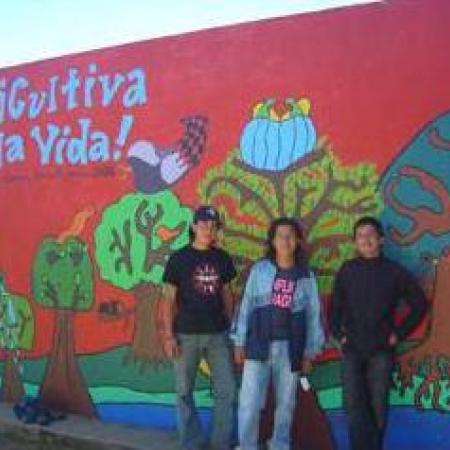
JEM d'une entreprise
En 2012, Jóvenes en la Misión (Jeunesse en mission, JEM) comptait 200 membres activement impliqués dans la municipalité de San Marcos et un total de 2 000 jeunes travaillant ensemble sur les questions liées à l'eau au Guatemala. La devise de JEM est "Unis pour l'eau" et la plupart de ses activités ont une composante environnementale. Le JEM a eu une influence sur la politique locale, comme l'explique Feliciano Velásquez, président du comité de développement communautaire de San Pablo, Tacaná, et membre du conseil du micro-bassin hydrographique d'Esquichá : "... Le gouvernement provincial l'a remarqué. Les maires l'ont remarqué. C'était important. Avec l'aide du projet Tacaná, le JEM est devenu une ONG enregistrée en juillet 2005. Un an plus tard, le JEM a reçu un prêt qui l'a aidé à construire 19 serres irriguées au goutte-à-goutte qui produisent des fleurs et des légumes tels que des tomates, des poivrons et des concombres. Le développement économique communautaire est fondamental pour la conservation de l'environnement, note Ottoniel Rivera, coordinateur du projet Tacaná pour l'UICN : "Ces enfants ne veulent pas émigrer aux États-Unis comme tant d'autres. Ils veulent rester dans leur communauté, mais ils doivent gagner leur vie. Ils veulent protéger l'environnement, mais ils se demandent ensuite : "Maintenant que nous avons sauvé la forêt, comment allons-nous gagner notre vie ?
Aujourd'hui, le JEM continue de faire campagne et de défendre les questions liées à l'eau, en aidant à améliorer les moyens de subsistance grâce à l'utilisation de technologies appropriées et en soutenant le développement communautaire par le renforcement des capacités en matière de gouvernance de l'eau. Un plan stratégique a été élaboré pour guider ses activités. Parmi ses réalisations, le JEM a soutenu la reforestation pour améliorer l'approvisionnement en eau, ce qui a aidé plus de 800 personnes dans le micro-bassin hydrographique d'Esquiche, et a établi une plateforme virtuelle de dialogue pour renforcer les projets le long des frontières du Guatemala et du Mexique. Le JEM a désormais une forte présence nationale et est impliqué dans un mouvement de jeunesse national qui participe à de nombreuses activités liées au changement climatique et à l'eau, tant au niveau local que national.
Rédigé par Bill Hinchberger
